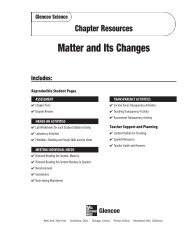Glenoce Science Level Red Study Guide - Glencoe
Glenoce Science Level Red Study Guide - Glencoe
Glenoce Science Level Red Study Guide - Glencoe
- No tags were found...
Create successful ePaper yourself
Turn your PDF publications into a flip-book with our unique Google optimized e-Paper software.
Name Date Class3Directions: Match the information in Column I with the best way to display it from Column II. Write the letter ofthe correct term in the blank at the left. A letter may be used more than once.Column I<strong>Study</strong> <strong>Guide</strong>1. view of Earth from space2. amount of rainfall in an area each month for a year3. how the constellations change position over several hours4. percents of the most abundant metals in Earth’s crust5. percents of the different gases in the atmosphere on Mars6. how far a hurricane moves each hour7. structure of the human ear8. daily high and low tide times for a week9. how a sound wave travels through the airDrawings, Tables, and GraphsChapter2Column IIa. bar graphb. circle graphc. drawingd. line graphe. movief. photographg. tableCopyright © <strong>Glencoe</strong>/McGraw-Hill, a division of The McGraw-Hill Companies, Inc.Directions: Use the paragraph below to complete question 10.Some animals can live much longer than others. For example, both the golden eagle and theblue whale have a maximum life span of more than 80 years, while a guppy’s maximum life span isonly 5 years. A giant spider may live 20 years, a lobster 50 years, and a crocodile may live 60 years.10. Make a chart and draw a graph to display the data given in the paragraph.Measurement 7














